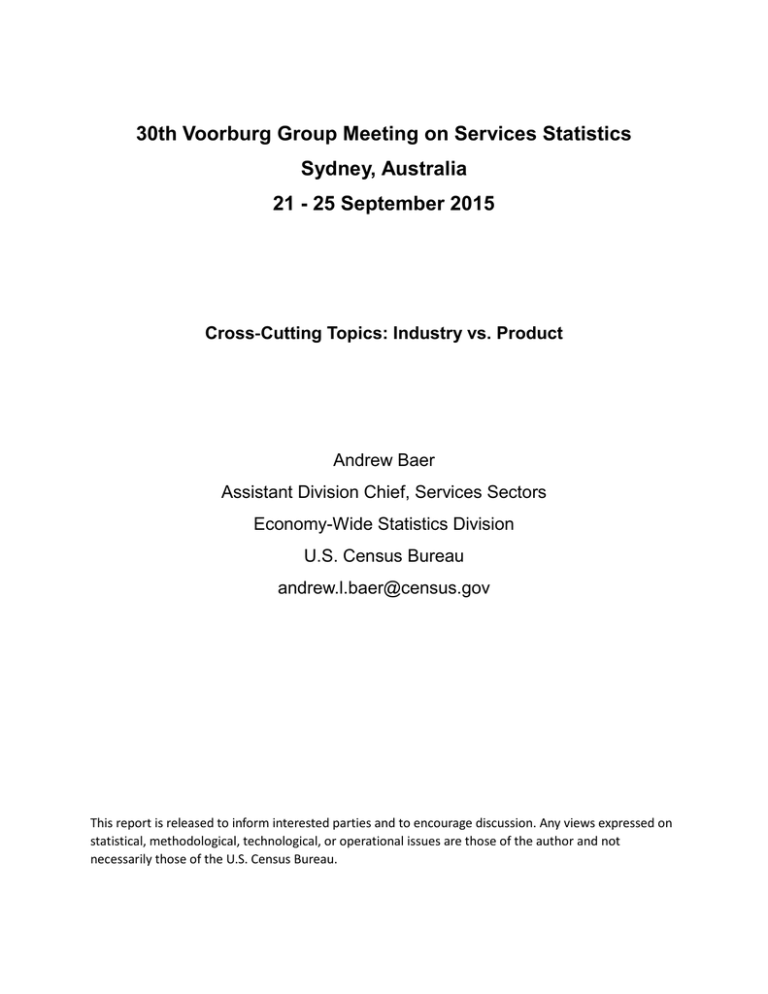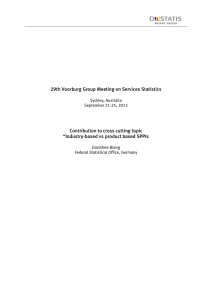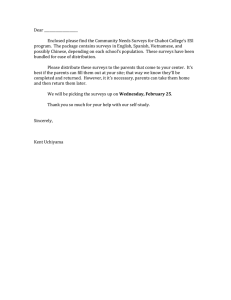30th Voorburg Group Meeting on Services Statistics Sydney, Australia
advertisement

30th Voorburg Group Meeting on Services Statistics Sydney, Australia 21 - 25 September 2015 Cross‐Cutting Topics: Industry vs. Product Andrew Baer Assistant Division Chief, Services Sectors Economy-Wide Statistics Division U.S. Census Bureau andrew.l.baer@census.gov This report is released to inform interested parties and to encourage discussion. Any views expressed on statistical, methodological, technological, or operational issues are those of the author and not necessarily those of the U.S. Census Bureau. This paper considers the practical implications of producing price and turnover data from industry-based and product-based surveys, and discusses the U.S. experience in this area. Industry-based surveys are defined here as data collection covering all economic production from establishments or enterprises within the same industry classification group. In contrast, product-based surveys typically collect transaction data only for a particular type of good or service, from those establishments or enterprises known to produce it. Challenges with Product-Based Surveys In the U.S., Service Producer Price Index (SPPI) industry-based samples are selected every five to eight years on a rotating basis. For example, in 2015 a new industry-based sample may be selected for North American Industry Classification System (NAICS) industry 721110, Hotels and Motels. U.S. Bureau of Labor Statistics (BLS) field economists will then visit the sampled hotels and conduct an hour-long meeting in which they perform a statistical selection of the transactions to be priced, giving all goods and services offered by the hotel a chance to be selected. This would include not only lodging services, but also food and beverage services provided by these establishments. Field economists would not visit the hotel again until 20202023, and then only if the property was selected in the subsequent SPPI industry-based sample. If the U.S. instead chose to select product-based SPPI samples, data would be collected for all lodging service providers in 2015. This would include not only firms classified in NAICS 721110, but also those classified in NAICS 721120 (Casino Hotels), NAICS 721191 (Bed and Breakfast Inns), NAICS 721211 (Recreational Vehicle Parks and Campgrounds), and other related industries. In 2016, a product-based sample of food and beverage service providers may then be selected. With this product-based sampling scheme, establishments that provide both lodging and food and beverage service may be asked to schedule meetings with a field economist in subsequent years. This creates an additional reporting burden and may harm response rates for voluntary U.S. SPPI surveys. This is particularly true for the large conglomerate firms that offer a broad variety of products and services and consequently would be visited repeatedly for multiple product surveys. Another significant impediment to creating product-based surveys is lack of adequate sampling frames. Most business economic survey samples are selected from business registers or national tax records. In the U.S., these data sources do not provide information on business activity by product. This is because most business respondents do not organize their records to allow for enumeration of employment, turnover, or wages for production of a specific good or service. Without these data, probability proportionate to size sampling for product-based surveys can only be achieved through alternative data sources and/or extensive imputation of producer size measures. These alternative methods typically do not provide the same comprehensive and accurate coverage as tax or business register sources. Since product-based sampling frames are usually of a lower quality, misclassification may also present challenges. With an industry-based sample, if a firm is found to be classified in a different but related industry, data collection may still occur. However, if a firm selected for a product-based sample is found not to transact the specified product, data collection is not possible. This creates an inefficiency of resource usage for product-based samples. Benefits of Product-Based Surveys The most significant advantage of product-based surveys is that they provide for a data userfriendly organization of transaction data. While the NAICS industry classification is organized based on the method in which establishments produce goods and services, the North American Product Classification System (NAPCS) groups products based on how buyers demand goods and services. For example, NAICS provides distinct industries for wired, wireless and satellite telecommunications providers, as these firms use varying methods to produce telecommunications services. Since prices and turnover for telecommunications services in the U.S. are determined by competitive market conditions between each of these distinct types of producers, product-based cross-industry data that represent all of these transactions may provide more clarity about business competition and market pricing. In the U.S., product-based SPPIs are created by re-organizing the transaction data collected from industry-based surveys. For example, the home telephone services transactions obtained from wired, satellite, and other telecommunications providers are combined to create a single home telephone service product-based SPPI. The contributions of the aggregated transactions from each respective industry are weighted based on product-by-industry turnover data published by the U.S. Census Bureau. Using product-by-industry turnover data to weight product-based SPPIs Wired Satellite telecommunications telecommunication industry SPPI industry SPPI Other telecommunications industry SPPI Industry total turnover $1 billion $500 million $250 million Home telephone services $200 million $100 million $50 million Business telephone services $100 million $50 million $25 million Programming services $400 million $200 million $100 million Data services $300 million $150 million $75 million Home telephone service product-based SPPI Product total $350 million 100% Home telephone services from wired telecommunications firms $200 million 57% Home telephone services from satellite telecommunications firms $100 million 29% Home telephone services from other telecommunications firms $50 million 14% There are two significant challenges with this approach. First, individual establishment weights are derived by multiplying the collected establishment turnover by a “sampling factor”. This factor increases the contribution of smaller units so that they also represent the activities of similarly sized units that were present but not selected from the industry sampling frame. Since these similarly sized industry units may not sell the same products, it may not be appropriate to represent their activity in the product-based SPPI data. Sampling factors that are suitable for a product-based SPPI should ideally be obtained through a product sample. The second challenge is that some firms have leading market positions in a broad number of product areas. This is particularly true for large national retailers, such as those classified in NAICS industry 452910, Warehouse Clubs and Supercenters. For example, a large retailer may report the following sources of turnover: Retailer A and total market sales by product line Retailer A Sales % of Retailer A Sales Total Market Sales Retailer A Market Share Groceries $100 billion 71.0% $1 trillion 10.0% Pharmaceuticals $20 billion 14.0% $1 trillion 2.0% Apparel $10 billion 7.0% $500 billion 2.0% Electronics $10 billion 7.0% $200 billion 5.0% Books $1 billion 0.7% $10 billion 10.0% $500 million 0.3% $2 billion 25.0% Greeting Cards If Retailer A were selected in an industry-based sample, standard probability proportionate to size item sampling would lead to the selection of grocery products for the majority of the items. Books and greeting card sales, each representing less than 1% of total turnover would typically not be selected at all. However, in many cases large U.S. retailers have leading market positions for products that generate a small portion of their total sales. While greeting card sales contribute a trivial portion of Retailer A's total turnover, these sales are very important in the context of total U.S. greeting card sales. If a product-based survey was used to collect greeting card sales only, Retailer A would have substantial weight in the sample. U.S. Experience with Product-Based Surveys All U.S. SPPI and turnover data is currently collected using industry-based surveys. However, product-based surveys are used to collect U.S. import and export price indexes by the BLS International Price Program (IPP). This is possible because every legal U.S. import and export is recorded by U.S. Customs and Border Protection. These reported transactions are classified with the product-based Harmonized Tariff Schedule of the U.S. to determine what tariff, if any, should be applied to the traded good or service. The universe of recorded import and export transactions serves as the sampling frame for the IPP. These transactions are then organized into product-based sampling strata. When the transactions are selected, IPP staff then identifies the business establishment that engaged in the selected import or export activity. The reporting unit is then defined as all import and/or export activities of the establishment within the relevant product area. The IPP experience illustrates many of the benefits and challenges associated with productbased surveys. A positive aspect of their product-based approach is that they are completely certain of the exact type of transaction they will collect when they visit the sampled establishment. This makes questionnaire preparation and data collection training easier than for industry-based surveys, where various types of secondary activity are often encountered. IPP also experiences the response burden challenges of repeatedly visiting the same establishments as they are selected in multiple subsequent product surveys. Impact on National Accounts Calculation of Volume of Services Outputs The U.S. compiles both National Income and Product Accounts (NIPAs), and GDP-by-Industry Accounts. While product-based surveys provide effective deflators for the NIPAs, industrybased surveys are needed to identify real volume measures of industry outputs. The U.S. Bureau of Economic Analysis regularly re-organizes both product-based and industry-based SPPI and turnover statistics to create data most suited for deflating a particular series.




